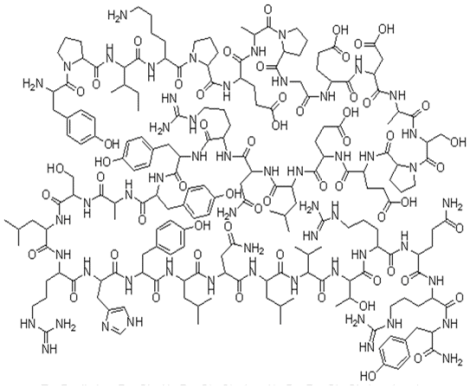2017-04-27
Introduction
The pancreatic polypeptide (PP) family includes three endogenous peptides: PP, peptides-neuropeptide Y (NYP) and peptide YY (PYY)-all of which have been localized to both central and peripheral tissues. Pancreatic polypeptide (PP) was first isolated as a by-product of insulin from avian species. Subsequent to this finding, were the discoveries of two other related peptides-neuropeptide Y (NYP) and peptide YY (PYY), which were isolated from porcine brain and gut, respectively. These three endogenous peptides have been demonstrated to have significant structural homology and these similarities have resulted in their classification as the PP family of peptides.
Peptide YY (PYY) is a 36-amino acid peptide that is synthesized and released from specialized enteroendocrine cells called L-cells found predominantly within the distal GI tract. It was discovered by Tatemoto in 1980, and named after the single letter short from tyrosine (Y), on behalf of two tyrosine found flanking its C- and N-terminus. Two molecular forms are produced by the L-endocrine cells of the distal gut, PYY1-36 and PYY3-36 and are released into the bloodstream following meals. In mammals, the serine protease, dipeptidyl peptidase 4 (DPP4) cleaves PYY(l-36) at the proline-alanine (YP) region of the N-terminal to produce a truncated peptide, PYY(3-36). Both forms of PYY, PYY(l-36) and PYY(3-36) are multifunctional hormones that delay gastric emptying, modulate pancreatic and gastric secretions, reduce cardiac output, cause vasoconstriction, and reduce glomerular filtration rate.

| CAT# | 10-101-97 |
| Product Name | Peptide YY (human) |
| CAS No. | 118997-30-1 |
| Sequence | H-Tyr-Pro-Ile-Lys-Pro-Glu-Ala-Pro-Gly-Glu-Asp-Ala-Ser-Pro-Glu-Glu-Leu-Asn-Arg-Tyr-Tyr-Ala-Ser-Leu-Arg-His-Tyr-Leu-Asn-Leu-Val-Thr-Arg-Gln-Arg-Tyr-NH2 |
| M.W/Mr. | 4309.81 |
| Molecular Formula | C194H295N55O57 |
Peptide YY Distribution and Processing
In mammals, PYY immunoreactivity is found along the length of the gastrointestinal tract, however, the most abundant source of PYY is in the distal gut. PYY is released from the gut into the circulation in a nutrient-dependent manner. PYY levels are low in the fasting state, rapidly increase in response to food intake, reach a peak at 1–2 h after a meal and then remain elevated for several hours. In response to food intake PYY levels increase within 15 min, before nutrients have reached the L-cells, implicating either a neural or hormonal mechanisms in this initial release. The temporal profile and peak PYY levels are influenced by caloric load, macronutrient composition and food consistency.
Function
PYY regulation of the gastrointestinal tract is complex. In healthy human patients, PYY intravenous infusion slowed down gastric emptying and transit time from mouth to cecum. These postprandial actions have led to the belief that PYY helps mediate the "ileal break", a time when the transit of food is delayed in order to assist in the absorption of nutrients. When centrally injected into rats in vivo, PYY inhibits gastric emptying by inhibiting acetylcholine induced contractions, and stimulates phasic contractions of rat duodenum. In a study by Fox-Threlkeld et al. (1993), the presence of PYY on in vitro canine ileum preparations, stimulated phasic contractions by inducing the release acetylcholine while inhibiting the release of nitric oxide. In the colon, both in vivo and in vitro studies in cats and guinea pig have demonstrated that PYY inhibits colonic motility. In addition, another study suggested that PYY may be responsible for mediating the short chain fatty acid induced inhibition of myoelectric colonic activity.
Reproduction
In recent years, PYY has gained attention as a potential regulator of reproductive functions in mammals. Central administration of PYY(3-36) in rats has been shown to directly release luteinizing hormone (LH) and follicle-stimulating hormone (FSH) from the pituitary, an effect that is enhanced by fasting. The actions of PYY(3-36) are attributed to activation of the Y2 receptor, as the Y2 receptor antagonist BIIE 0246, significantly decreased circulating levels of both LH and FSH. In addition, while PYY(3-36) was found to increase pituitary sensitivity to GnRH release it has also been shown to inhibit GnRH secretion from hypothalamic fragments in vitro from male rats fed ad libitum.
Reference:
Jun, Jenny Mary. Area Postrema: A Potential CNS Target for PYY Effects on Feeding. ProQuest, 2007.
Rangel, Ronald Guillermo Gonzalez. Molecular, Immunohistochemical and Functional Characterization of the Vertebrate Hormones, Nesfatin-1 and Peptide YY. York University, 2011.